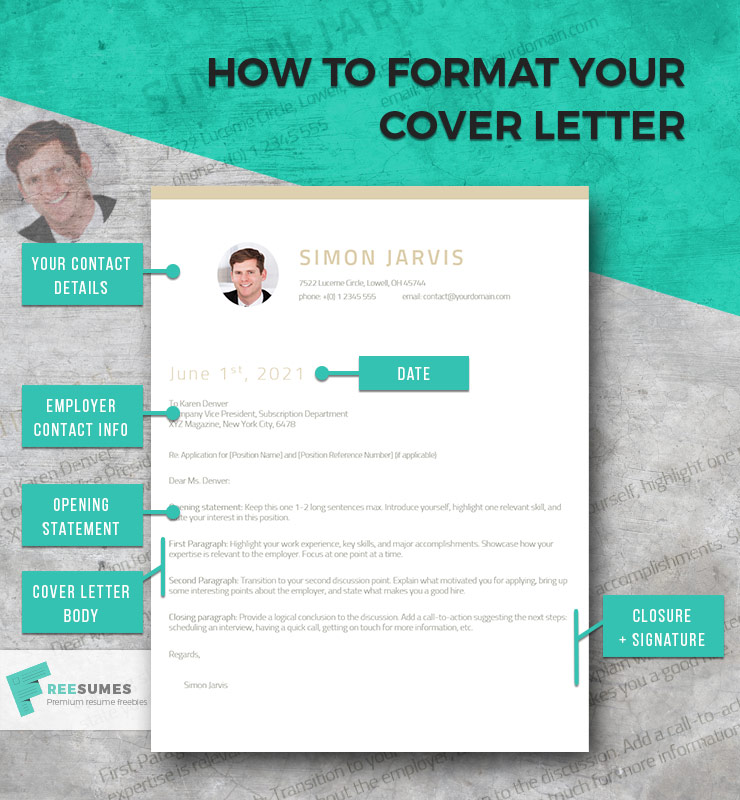The cover letter is what most employers will read first.
This means they will form their first impression about you from this document. So you’d want to make it look professionally polished and memorable. That’s what a business cover letter format is for! It helps you mold your narrative in a sharp, witty, and compelling cover letter.
How To Format a Cover Letter
A proper cover letter format is dead-simple. All you need to do is get the four core parts right:
- Cover letter header — the topmost area featuring your contact details and employer details.
- Cover letter opening — the first paragraph capturing the attention and curiosity of the person reading it.
- The body of your cover letter — two or three paragraphs, detailing your experience, accomplishments, and key value proposition for the employer.
- Cover letter closure — the final short paragraph with a call to action.
Now that’s the general cover letter layout.
If you are sending a cover letter as a Word document rather than an email or form submission, you’ll also need to make sure that it’s readable.
Here’s a standard format for cover letter text document:
- Use the standard one-inch (2.5 cm) margin in MS Word
- Apply align center to all contents
- Keep a readable letter spacing of 1 or 1.15.
- Use a professional font such as Arial or Times New Roman
- Leave a double space after each paragraph
- Check that all hyperlinks (if you include any) are clickable
- Save your cover letter in Word and PDF format (and send over the requested one)
- Optional: you can also use a professional cover letter template, featuring the above format settings.
Now let’s put the microscope over each cover letter section.
Cover Letter Format Template
Your Name
Address
Telephone Number
Email
Website or LinkedIn (optional)
Date
Employer’s Name
Job Title
Company Name
Company Address
Re: Application for [Position Name] and [Position Reference Number] (if applicable)
Dear/Mr/Ms [Hiring person name]
Opening statement: Keep this one 1-2 long sentences max. Introduce yourself, highlight one relevant skill, and state your interest in this position.
First Paragraph: Highlight your work experience, key skills, and major accomplishments. Showcase how your expertise is relevant to the employer. Focus at one point at a time.
Second Paragraph: Transition to your second discussion point. Explain what motivated you for applying, bring up some interesting points about the employer, and state what makes you a good hire.
Closing paragraph: Provide a logical conclusion to the discussion. Add a call-to-action suggesting the next steps — scheduling an interview, having a quick call, getting on touch for more information, etc.
Regards,
Name, Signature
Cover Letter Format Sample (Word version)

Download cover letter format sample (.docx)
Cover Letter Header Format
This step is optional if you are sending an email cover letter.
However, if you prefer to go for the most formal cover letter format, you’ll have to nail header styling.
A header needs to feature your contact details first, followed by the employer details.
Here’s a cover letter header template:
Your Name
Address
Telephone Number
Email
Website or LinkedIn (optional)
Date
Employer’s Name
Job Title
Company Name
Company Address
Quick note: If you don’t know the hiring person’s name (and job title), go straight to the company name.
Cover Letter Opening Format
The open section of your cover letter serves two purposes:
- Reiterates which position you are after and why
- Hooks the reader into learning more about you
Usually, a cover letter opening consists of two or three sentences. Don’t go beyond that. Your goal is to provide a teaser, not showcase the full movie.
Here are several sample cover letter openings:
For a cover letter for social worker:
“Dear Hiring Manager,
The opportunity to apply for the position of Social Worker at the Denver Regional Office of the Department of Social Services is very appealing to me. When I read the job listing on Indeed.com, I realized that my experience as an elderly care coordinator at St Milrose Institution could help you achieve the goal of improving outreach efforts within the local community.”
For a cover letter for a marketing position:
Re: Marketing Content Writer (Job Reference Number #123456) at Startup
Ms. Symone,
Over the past 5 years, I wrote website copy, blog posts, and eBooks for brands such as Slack, Shopify, and BigCommerce. My best performing eBook drover over 800 qualified leaders over the span of 2 years. I’d be delighted to help Startup achieve similar results in the position of Marketing Content Writer.
Cover Letter Body Format
The body of your cover letter should be succinct (around 200-250 words), yet informative enough to deliver the information that the employer is looking for.
Thus, pick out hard and soft skills, core competencies, and employment facts that will grab their attention the most and encourage them to read your resume.
Next, ensure that you always customize your cover letter to the job application.
This is probably THE most important tip that we can pass on to you. Customization is the key to a successful cover letter.
Here’s how to do it:
- Detail the specific skills you possess that the company is looking for.
- Use phraseology that mirrors the company language – mimics how they speak. Describe your skills and knowledge in a way that the company would describe them.
- Drop the common industry buzzwords. Instead, infuse some extra personality and power words.
To effectively personalize a cover letter, research the company before you apply.
Read their back history, the company ethos, and their beliefs. If they meet and align with your own then this makes it easier for you to speak with genuine passion about why you want to work for the company in your cover letter.
Always remember that the company will be swamped with perfectly qualified job candidates with the exact same skill-set and work history like you. What makes a candidate stand out is someone that is very well-informed about their company and has shared beliefs and goals.
Check out our collection of cover letter examples to see how the cover letter body should be laid out and personalized.
Cover Letter Closure Format
Keep the closing paragraph of your cover letter short and action-oriented. Drop the “thank you for taking the time to consider me”.
Instead, go bolder and more proactive. Ask the employer to:
- Reach out if they have any questions or would like extra information
- Meet in-person or via Zoom for a preliminary chart
- Invite you for an interview
We have a separate guide detailing how to close a cover letter with a bang!
Extra Cover Letter Formatting and Writing Tips
Still, feel stuck with writing that cover letter?
Here are some bite-sized tips to get you going!
1. Always Analyze the Job Requirements
Note down what skills are listed the highest in the Requirements section. Jot these down and incorporate the ones you have into the cover letter.
Also, look at who the company mainly deals with. Do they focus on B2C or B2B? This will give you an idea about how to phrase your language in your cover letter. If this is a B2B company you can highlight and reinforce your B2B experience. This will help you to stand out more than a similar candidate with only B2C experience and vice versa.

2. Go with a Format You Use for Your Resume
Your cover letter is not only a tool of introduction, but it also helps to back up your resume. Thus, make these two documents look consistent.
Specifically:
- Use the same font size and style as you use for your resume.
- Keep the same margin sizes and spaces
You can make it a lot easier on yourself if you chose to use a resume template with a matching cover letter. In this way, you can make sure that both documents look like twins, not some distant cousins.
3. Remain Humble
The last thing you want to do is to put off your potential new employer by coming across as a big-headed know-it-all in your cover letter.
While it is fine to talk positively about yourself and your achievements that are relative to the job in hand, it never sounds good to brag. Instead, stay professional and courteous in your address.
The employer will be looking for a candidate that will fit in well with others in their company. They will be looking for someone that has the knowledge and experience they need, but will also be open-minded and willing to learn from their peers.
4. Check, Edit, Check, Edit, Then Check and Edit Again
You will be amazed at how many resumes and cover letters get rejected because of reasons such as poor grammar, spelling mistakes, repeated information and obvious typos.
While you may be tempted to shoehorn a lot of information into your cover letter, remember that it needs to be kept short. By reviewing and editing your cover letter you can cut out on excessive words or long explanations that can be said in fewer words.
5. Get Someone Else To Review Your Cover Letter
It is always worth having a fresh pair of eyes to scan over your cover letter. Having someone else check your letter may draw your attention to something you missed, such as poor grammar or phraseology, a spelling mistake, or a feeling that the letter is too long/too short etc.
What you need is an objective pair of eyes to cast a look over your letter, so choose someone that you know will give you an honest opinion and isn’t afraid to appraise it with a critical eye.

Choose a trusted work colleague or a friend that has your best interests at heart. This way you will get an honest opinion rather than flattery or praise for your efforts.
To Conclude
We hope that our tips and cover letter format example prepped you well for writing a compelling cover letter.
But if you still don’t feel that confident, check our complete guide to cover letter writing. It’s choke-full of even more examples, tips, and templates for writing.
Do remember that your cover letter gives you a chance to get your foot in the door for an interview. Try to stick to the points above and avoid any negative language that will be a turn off to a potential new employer.
Don’t include information that is already listed in your resume. Never repeat your resume in your cover letter. The employer will not appreciate reading the same information twice.
Good luck with your next job interview!






